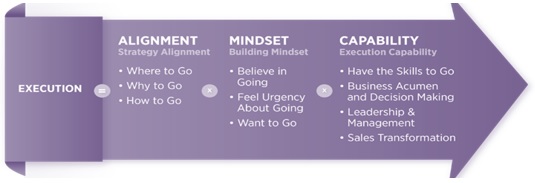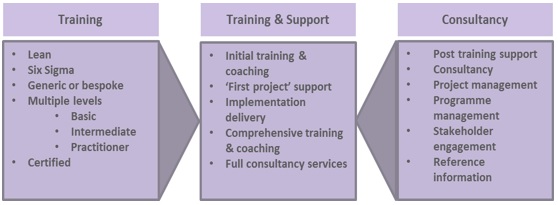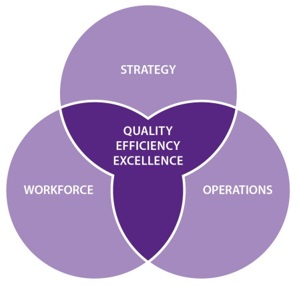Keith Parsons, Managing Director, Dembridge provides an insight into learning and delivering Lean Six Sigma
People see Lean Six Sigma as a massive toolbox. It is much more than that.
It is true that there are many, many tools that can be used to bring about improvements, but the real objective of Lean Six Sigma (LSS) is to bring about changes in behaviour – culture change. This cultural change, as we know, can take years to embed within the organisation. It is a journey. To realise this, “it is about developing employees” as Ruth Stuart at CIPD quite rightly cites.
All organisations invest in their people in order for them to contribute to the organisation’s overall performance. To do this successfully, capability on all fronts – employee and organisational – is fundamental to realising a return on this investment. Having a structured learning programme in place significantly enhances the chances of improving capability.
Cultural Building Blocks
All too often these LSS methodologies are treated as a group of tools to be applied rather than a new cultural behavioural pattern that starts with the executive team. Too much focus has been applied to teaching the tools related to these methodologies in a two-level focus on embedding the Lean and Six Sigma cultures into the organisation. As a result, these initiatives are often treated as projects where people are trained, problems are solved, and the immediate problem is to put to bed while the organisation goes back to business as usual. When this occurs, savings are short-lived and the problems that were put to bed soon wake up and have to be addressed again and again.
The person that makes the LSS methodology a success within an organisation is not an LSS Black Belt or even an LSS Master Black Belt. The people who make LSS a success are the executives who will not be satisfied with any waste within the organisation and who won’t allow anything but exceptionally good products and services to be provided within or as output from the organisation he/she is responsible for. It is the executive who doesn’t have excellence as a goal, but as a standard of today’s performance for himself/herself and everyone within his/her organisation, who is the ideal role model for the organisation.
These are hard requirements to meet, but it’s what is required to be successful in today’s highly competitive environment. LSS Green Belts and LSS Black Belts can bring about significant changes and improvement in organisational performance, but these gains often last for only a short period of time unless there is a significant change in the fundamental culture within the organisation. Business excellence in an organisation encompasses the areas of strategic focus or intent, customer loyalty/advocacy, employee delight, and seamless process integration. All the business excellence models have these areas incorporated in their models in different ways
Alignment, Mindset & Capability
There are many methodologies to choose from when considering organisational improvement and arguably, the fastest growing is Lean Six Sigma. Why? Lean and Six Sigma – both different methodologies – offer different objectives. Lean deals primarily with efficiency whilst Six Sigma focuses more on effectiveness. So, combined, this all- embracing continuous improvement methodology provides a mechanism for not only improving efficiency (Lean) but also focuses on quality (Six Sigma).
It is important to note that LSS methodologies are all organisation-wide operational philosophies/strategies with accountability and strategic focus. The real value of LSS starts to show when it is integrated with the organisation’s strategic plan, helping to implement that plan with a focus on the end-use customers. In order to achieve the true benefits of LSS, projects will cross-organisational boundaries and be focused on business processes. Sustained strategic results can be achieved when this is done. When applied to a business process, the benefits obtained move the organisation toward world-class performance in that business process.
At the heart of all successful LSS programmes is an effective infrastructure that translates the strategic goals and activity areas of the organisation into short-term action plans that maximise value and provide proper governance and management, along with the monitoring of results.
Lean Six Sigma is viewed by many to be their primary vehicle for positive change owing to its unique structured approach to effecting improvement. This structured approach, known as DMAIC (see next section for definition) takes people through a phased approach facilitating a clear pathway to achieving the organisational goals.
Needless to say, learning and understanding the LSS methodology in order to facilitate positive change can bring huge rewards to both the organisation and to the employees. As outlined, this learning needs to be aligned to the strategic agenda of the organisation and whilst LSS is generic in its nature, it is important that the learning programme is developed that ‘fits’ with organisational framework. Time spent on this development will ultimately be rewarding to all concerned.
Design & Delivery
To truly capitalise on the benefits of continuous improvement all people involved in the process also need to be involved in the improvement project. Working in isolation does not work and the inclusion of all the different functions in the project is central to its success as the aim to achieve a goal that delivers a seamless process flow cross-functionally.
There are many ways that this can be achieved, although the proven process is illustrated below and one that is highly recommended.
It is important to note that attending a training programme and learning about LSS is just
the beginning. Obtaining a certificate does not mean that you are a fully fledged ‘practitioner.’ A return on investment is a fundamental requirement to any organisation and only when the learning is translated into tangible benefits can this ROI be quantified. This can be a hard task for newly trained employees which is why post support from experienced experts is pivotal to the learning extension and of course, that all important ROI!
But, the technical training is still insufficient in order to bring about this much desired positive change. This training must include the critical managing change elements without which will severely suppress the vital stakeholder engagement objective. Included within the training then, should include at least the following, in addition to the tools and techniques of LSS:
- Managing Change
- Emotional Cycles of Change
- Resistance to Change
- RACI
- Developing High Performing Teams
- Stakeholder Management & Analysis
- Brainstorming Techniques
- Leadership
A learning programme that combines the mechanics of LSS with the necessary ‘soft skills’ is critical in order to get the best outcomes from the methodologies of LSS. The fundamental requirement of engaging people and developing a culture of continuous improvement cannot be overstated.
A Framework for Progression
Typically, companies enlist the expertise of consultants to assist them in delivering improvements against a defined strategy and its associated objectives.
To fulfil all objectives of your continuous improvement journey, it must embrace the three core pillars: Quality, Efficiency and Excellence.
Fundamental to the successful execution of these three pillars is a structured approach that ensures integration. This starts with a review of the organisation as a whole and drilling down from this into its components.
Only through this approach can all of the pillars be effectively identified, measured and improved. The model illustrated here is a proven approach in delivering against corporate and functional strategy and ensures integration.
Often, people trained in LSS obtain the theoretical intelligence (and hang a nice certificate on the wall) but don’t actually deliver the results expected by the organisation. This is due, typically, to the absence of an identified project(s) prior to the training that dilutes the requisite ROI. The most successful organisations undertaking LSS training have clear pre-training briefs, agreed projects and post training de-briefs with a ‘hit-the-ground-running’ attitude post training. These identified projects are aligned to the corporate / functional strategy.
Just the Facts
- Lean Six Sigma is concerned with behavioural change
- Cultural development is central to success of Lean Six Sigma
- Alignment to corporate / functional strategy is pivotal
- Clear project(s) identification prior to any training is important
- The tools of LSS are just that – tools
- Executive sponsorship is critical
- Return on Investment can be significant
Any organisation that can tick all of these boxes are in a strong position in creating an environment of organisational improvement and employees that are driven, inspired and motivated to realise the desired return on investment.











